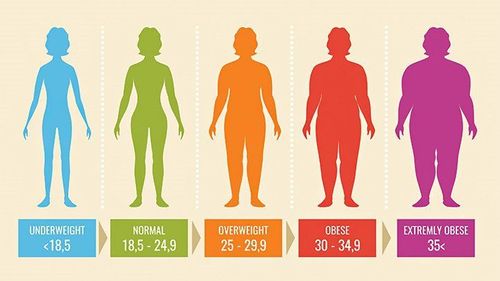This is an automatically translated article.
The article is professionally consulted by Master, Doctor Nguyen Thi Ngoc - General Internal Medicine - Endocrinology - Department of Examination & Internal Medicine - Vinmec Central Park International General Hospital. Doctor has more than 10 years of studying, researching and working in the field of endocrinology.The term BMI (body mass index) is used to assess where your weight falls, based on the ratio between your height and weight. This is a commonly used index today, but is BMI the best way to know what your body condition is?
1. What is BMI?
BMI is a measure of body weight, calculated from a person's height and weight. BMI is divided into four categories:
Underweight: BMI less than 18.5 Normal: BMI between 18.5 and 24.9 Overweight: BMI between 25 and 29.9 Obesity: BMI with only numbers 30 and up But how useful are these numbers really?
According to one researcher, there are about 90 to 95% of the population for teeth, BMI is a general measure of obesity.
But some critics have a different view, arguing that to define obesity requires a certain cut-off on the BMI scale. Measuring whether someone is obese based solely on their size is really not a useful and rather outdated method.
In fact, there are many overweight people who are still very healthy, BMI does not really reflect the health risks. They are overweight and have a BMI in the obese range, but their health is quite stable with stable cholesterol and blood pressure levels, and blood sugar levels are also in a reasonable range. There did not appear to be any health effects associated with their excess weight.
While BMI is useful as a quick screening tool, simply looking at that number for assessment is not enough.

Chỉ số BMI từ 25 đến 29,9 báo hiệu bạn đang thừa cân
2. Limitations of BMI
BMI does not determine any other part of your body, such as how much body fat you have... That's why conclusions based on this number alone can be It can be confusing, especially when it comes to some of the following:
How much muscle do you have : A person has a high BMI but doesn't have much body fat. Their muscle tissue pushes the weight up. Example: A soccer player or a builder has a very muscular body. Their BMI appeared quite high, but their body fat was quite low. Your activity level: A sedentary person can have a BMI in the normal range, have a lot of body fat, even though their appearance looks very normal. For example, in the elderly, the BMI may look within the normal range, but in reality the percentage of body fat is quite high compared to the total body mass. different on the body: when fat accumulates in the abdomen (belly fat) puts you at higher health risks elsewhere. Fat accumulation in the abdomen increases the risk of heart disease and type 2 diabetes. Fat that accumulates in the hips and thighs is less likely to cause harm. Age: The concept of an ideal BMI can change with age. Experts say that older adults can be a little overweight, but BMI should be limited to 30. Ethnic differences: There is a lot of variation in BMI and health risks. among ethnic groups. For example, Asian Americans tend to have lower health risks, including diabetes risk, with a lower BMI than Caucasians. A healthy BMI for Asians ranges from 18.5 to 23.9, well below the standard range. And Asians are considered obese, if the BMI is 27 or higher, compared with the standard obesity BMI BMI of 30 or higher. The standard definition of overweight is a BMI of 25 or more. But if you're from India, your risk of diabetes increases with a BMI between 21 or 22.
In contrast, many African-Americans may have a high BMI, but are not at risk. accompanying health. Compared with whites of the same weight and BMI, African-Americans tend to have less visceral fat and more muscle mass. Therefore, an African American with a BMI of 28, according to the chart, is said to be overweight, yet their body is as healthy as a Caucasian with a BMI of 25.

Chỉ số BMI không cho kết quả chính xác giữa các nhóm dân tộc khác nhau
3. Other ways to check if you are overweight
In addition to BMI, you can use another way to check if you are overweight, such as using a measuring tape to measure:
Waist size : To measure accurately, the tape measure must go around your waist at the top of the hip bone in the lower back and around the navel. To prevent health problems from being overweight, men should keep their waist size no more than 39 or 40 inches and women no more than 34 or 35 inches. Also due to ethnic differences, according to the Joslin Diabetes Center, Asian men should keep their waists no more than 35.5 inches and Asian women no more than 31.5 inches. Waist/height ratio: compare your waist measurement with your height. This is even more useful than just estimating waist circumference. Normally, your waist circumference will be less than half your height.

Thước dây có tác dụng kiểm tra xem bạn thừa cân hay không
Currently, at Vinmec International General Hospital, through regular health check-ups, you will be accurately assessed your body's indicators, in addition, regular health checks also help you detect get sick early, save money, save time, and at the same time have a high cure rate. In addition, Vinmec International General Hospital also deploys a variety of general health check-up packages, suitable for the choice of many subjects, including:
Children's general health check-up package Health check-up package general health Standard General health check-up package Comprehensive General health check-up package Special VIP general health check-up package Diamond general health check-up package.
Please dial HOTLINE for more information or register for an appointment HERE. Download MyVinmec app to make appointments faster and to manage your bookings easily.
Article referenced source: Webmd.comMORE:
Gym and sports: Information for beginners How to build muscle properly? Gym workout guide for beginners













